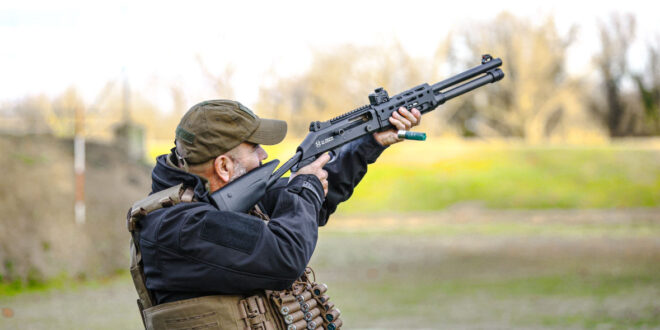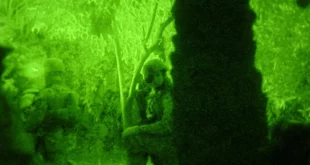by Austin Lee
In the escalating drone wars, where fiber optic and First-Person View (FPV) drones threaten soldiers and civilians alike, one man is turning the art of clay shooting into a battlefield advantage.
Lieutenant Marco Angelelli, an Italian Air Force reserve officer and Italian Clay Pigeon Shooting Federation (FITAV) athlete, has developed a groundbreaking training program to teach battlefield operators how to use shotguns to fight off small, agile drones. As a follow-up to my previous article, “Countering Drone Swarms,” I sat down with Angelelli to explore how his decade of competitive clay shooting has helped his Counter-Unmanned Aerial System (C-UAS) techniques. From the best shotguns to specialized ammunition and training drills, Angelelli shares his insights on why shotguns remain a soldier’s best defense against the drone threat.
Best Shotguns for Countering FPV Drones
Question: In your experience, what shotguns have you found to be most effective and reliable for countering FPV drones, and what are the standout features that one should look for in a shotgun to suit this role?
Angelelli: I had the opportunity to participate in the development of the new Benelli Defense M4 AI Drone Guardian shotgun, the only shotgun designed for C-UAS/FPV drones. So, after firing thousands of rounds, I can say that the Benelli shotgun is currently the best on the market. It combines the reliability of the M4 with the technology of the new Advanced Impact barrel. The characteristics of a shotgun for C-UAS/FPV operations must certainly be reliability in all conditions and an effective range of at least 100 meters.”
READ MORE: Threatening Skies: Countering the Drone Swarm Apocalypse
Angelelli’s endorsement of the Benelli M4 AI Drone Guardian highlights its purpose-built design for C-UAS. The Advanced Impact barrel extends its range to more than 100 meters, crucial for engaging FPV drones that move at speeds up to 90 km/h – similar to the clay targets Angelelli mastered in FITAV competitions. The M4’s long proven reliability in harsh conditions, like dust, mud or rain, ensures the shotgun performs when lives are on the line, making it a standout for urban and battlefield drone defense.
Worst-Performing Shotguns for C-UAS
Q: What shotguns should be avoided, and what limitations (e.g., range, reliability, or handling) make them less than ideal for targeting small, agile drones?
Angelelli: “What I can say is that the Ukrainian armed forces initially adopted Turkish ‘bullpup’ shotguns but later adopted Italian shotguns.”
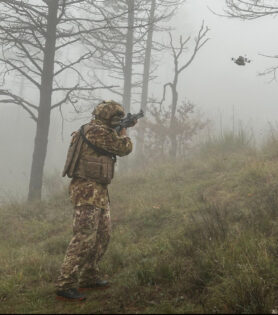
Angelelli in the field
While Angelelli avoids naming specific models, his reference to Ukrainian forces switching from Turkish bullpup shotguns to Italian designs suggests issues like limited range, poor ergonomics, or reliability problems. With lesser quality barrels reducing effective range below the 100-meter threshold critical for drone defense.
Gear Loadout for C-UAS Operators
Q: What does the gear loadout look like for a C-UAS shotgun operator, including accessories like optics, lights, and slings? How much ammunition do you typically carry, and what are the best methods to carry shotgun ammo gear-wise?
Angelelli: “The C-UAS/FPV operator’s equipment is essential, starting with an RF detector system, a night vision device (preferably thermal), a modified vest carrier to carry 12-gauge ammunition, and increased personal ballistic protection compared to a standard soldier (this is because the C-UAS/FPV operator is more exposed to shrapnel from the potential detonation of the FPV if hit in flight).”
Angelelli’s loadout prioritizes detection and protection. The RF detector identifies drone signals, while thermal vision enables low-light engagements, critical for 24/7 operations. A modified vest carrier holds 50–100 rounds of 12-gauge ammo, accessible via bandoliers or chest pouches for rapid reloading, mirroring clay shooting’s fast-paced demands. Enhanced ballistic protection – think heavier plates – guards against shrapnel from exploding drones, a risk underscored in our previous article on swarm threats.
Best Ammunition for Drone Defense
Q: Ammunition choice is critical for drone defense. What are the best ammunition types you have found to be most effective for countering FPV drones, and how do their characteristics (e.g., tungsten load, spread pattern) outperform standard ammunition?
Angelelli: “The most effective ammunition is loaded with military-grade tungsten, which must be different from the type used for hunting because it has better hardness. This type of cartridge has the advantage of greater penetration energy at long ranges (over 100 meters) and tighter patterns.”

Military-grade tungsten 12-gauge shells are Angelelli’s go-to for their hardness and penetration, outperforming standard lead birdshot or buckshot. Their tighter spread and energy retention at 100+ meters ensure a higher hit probability against small, fast FPV drones. Unlike hunting rounds, which scatter too widely or lose effectiveness at range, tungsten loads balance density and pattern for precise “hard kills.”
Motivation and FITAV Influence
Q: As a lieutenant in the Italian Air Force and FITAV athlete, what motivated you to start training operators to use shotguns against drones, and how did your clay shooting experience shape your approach to C-UAS?
Angelelli: “My 10-year experience in the national military clay pigeon shooting team was a significant influence because, from the first images of kamikaze FPV drone attacks, I understood how important it was for soldiers to have a personal defense tool, otherwise defenseless and doomed to certain death or very serious injury.”
Angelelli’s decade with FITAV’s military team, competing in SKEETand other disciplines, gave him a unique perspective. Seeing FPV drone attacks in Ukraine – small, lethal drones evading traditional defenses – he recognized shotguns as a soldier’s lifeline. His clay shooting skills, like tracking and hitting targets at 90 km/h, directly informed his C-UAS approach, turning drones into “clay targets with a payload.”
Encounters with Hostile Drones
Q: Have you or your team encountered hostile drones in training or operational settings? If so, how did your clay shooting skills, such as target acquisition, help you counter these threats, especially in scenarios involving multiple drones?
Angelelli: “Our C-UAS/FPV training protocols include courses ranging from basic SKEETclay shooting to advanced courses with target drones that simulate real drones but, once hit, can be quickly repaired and reused.”
Angelelli’s training at Italy’s La Torre clay shooting range in Pisa uses repairable target drones to mimic FPV flight paths. While he doesn’t confirm operational encounters, his drills replicate real threats, leveraging clay shooting’s rapid target acquisition to track multiple drones. “It’s about staying calm and prioritizing, just like in FITAV competitions,” he says, a skill critical for swarm scenarios.
Most Effective Non-Kinetic Method
Q: What is the most effective non-kinetic method you’ve trained with?
Angelelli: “The most effective training method is to start practicing clay pigeon shooting on some SKEETplatforms, such as the 1 Mark, 2 Mark, 6 Pull, 7 Pull, and 8 Pull and Mark stations, which simulate the flight path of an approaching FPV drone. The speed is also similar, around 90 km/h.”
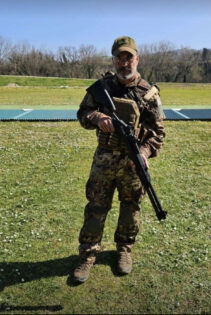
Angelelli’s response focuses on training, not a specific non-kinetic countermeasure, suggesting his expertise lies in kinetic solutions. However, he later mentions RF jamming as a key non-kinetic method, effective for disrupting drone communications. Our previous article noted jamming’s limitations against advanced drones, but Angelelli sees it as a vital complement to shotguns in layered defenses.
Biggest Drone Threat Today
Q: What is the biggest drone-related threat we face today, and how does your training prepare operators to address it?
Angelelli: “The most significant threat is attacks from FPV drones, particularly those with fiber-optic guidance, which are immune to EW. Therefore, the only effective defense method is a ‘hard kill.’ The shotgun, due to its characteristics, is an excellent personal defense tool not only for soldiers but also for law enforcement and security forces who must ensure the safety of sensitive installations or particularly important events. Our courses, reserved for military, law enforcement, and security personnel, are divided into two types: basic training for C-UAS/FPV drone operators and advanced training for C-UAS/FPV instructors. In Italy, we have a modern facility that we use as a training facility: the LA TORRE clay shooting range in Pisa. Our instructors are all experienced clay shooting athletes.”
Angelelli pinpoints fiber-optic-guided FPV drones as the top threat, as they bypass electronic warfare (EW) like jamming. His training at La Torre, using FITAV ranges and experienced instructors, prepares operators for “hard kill” engagements with shotguns. Basic and advanced courses ensure soldiers and security forces can protect critical sites, addressing the swarm threat highlighted in our previous article.
Why Shotguns Are the Best Kinetic Defense
Q: Why do you believe shotguns remain the best kinetic defense against small drones, particularly in close-range swarm scenarios, compared to other options like rifles, nets, or microwave systems?
Angelelli: “To be effective, the shotgun must be integrated into a multi-layered air defense system, which includes EW defense and ‘hard kill’ systems. Very important is that the C-UAS/FPV operator must be equipped with RF detector and night vision systems integrated with the air defense system. My motto is ‘every FPV drone killed is a soldier’s life saved.’ ”
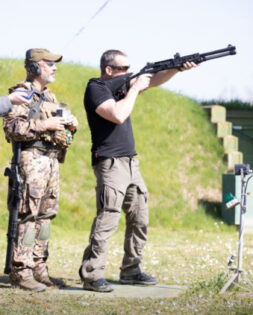
Shotguns excel due to their wide spread, affordability (compared to a missile), and ease of use at ranges up to 100 meters. Angelelli emphasizes their role in layered defenses, supported by RF detectors and night vision. Unlike rifles (requiring pinpoint accuracy), nets (slow and cumbersome), or microwaves (costly and complex), shotguns offer a practical, lethal solution for close-range swarms.
Adapting FITAV Techniques for C-UAS
Q: Your booklet “Individual C-FPV Drones with Shotguns” outlines training methods. How do you adapt FITAV clay shooting techniques to prepare operators for the unique challenges of shooting down FPV drones, and what specific drills do you use to simulate swarm conditions?
Angelelli: “In Italy, FITAV (Italian Clay Pigeon Shooting Federation) has made all its shooting ranges available for military training. We are currently conducting several training demonstrations at various Armed Forces units. The feedback has been very positive, and I believe this training method will soon be adopted not only by our Armed Forces, but also by NATO.”
Angelelli adapts SKEET drills (e.g., 1 Mark, 6 Pull) to mimic FPV drone flight paths, training operators to lead targets and engage with precision. Advanced drills with multiple target drones simulate swarms, building prioritization skills under pressure. FITAV’s support and NATO’s interest signal a growing recognition of this clay shooting-inspired approach.
A New Breed of Drone Hunter
Lieutenant Marco Angelelli is forging a new path in C-UAS, blending the precision of FITAV clay shooting with the urgency of modern warfare. His training, rooted in SKEET and Compak Sporting, equips operators to face FPV drones and swarms with confidence. With shotguns like the Benelli M4 A1 Drone Guardian and innovative drills, Angelelli aims to ensure that soldiers, law enforcement, and security forces are ready for the drone wars ahead.
Austin Lee is the proprietor of Galilhub, and is a gunsmith and a competitive shooter. He writes frequently for Soldier of Fortune.

 Soldier of Fortune Magazine The Journal of Professional Adventurers
Soldier of Fortune Magazine The Journal of Professional Adventurers


